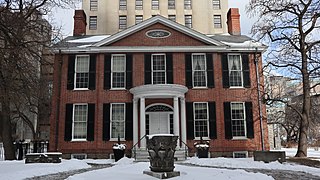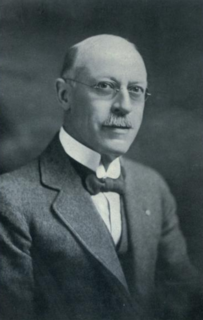
The Upper Canada Rebellion was an insurrection against the oligarchic government of the British colony of Upper Canada in December 1837. While public grievances had existed for years, it was the rebellion in Lower Canada, which started the previous month, that emboldened rebels in Upper Canada to revolt.

The Toronto-Dominion Centre, or TD Centre, is an office complex in the Financial District of downtown Toronto owned by Cadillac Fairview. It serves as the global headquarters for its anchor tenant, the Toronto-Dominion Bank, and provides office and retail space for many other businesses. The complex consists of six towers and a pavilion covered in bronze-tinted glass and black painted steel. Approximately 21,000 people work in the complex, making it the largest commercial office complex in Canada.

The Toronto City Hall, or New City Hall, is the seat of the municipal government of Toronto, Ontario, Canada, and one of the city's most distinctive landmarks. Designed by Viljo Revell and engineered by Hannskarl Bandel, the building opened in 1965. The building is located adjacent to Nathan Phillips Square, a public square at the northwest intersection of Bay Street and Queen Street, that was designed and officially opened alongside Toronto City Hall.

The Old City Hall is a Romanesque-style civic building and court house in Toronto, Ontario, Canada. It was the home of the Toronto City Council from 1899 to 1966 and remains one of the city's most prominent structures.

The Cathedral Church of St. James is an Anglican cathedral in Downtown Toronto, Ontario, Canada. It is the location of the oldest congregation in the city, with the parish being established in 1797. The cathedral, with construction beginning in 1850 and opening for services on June 19, 1853, was one of the largest buildings in the city at that time. It was designed by Frederick William Cumberland and is a prime example of Gothic Revival architecture.
Eric Ross Arthur, was a Canadian architect, writer and educator.

Campbell House is an 1822 heritage house and museum in downtown Toronto, Ontario, Canada. It was built for Upper Canada Chief Justice Sir William Campbell and his wife Hannah. The home was designed for entertaining and comfort, and constructed at a time when the Campbells were socially and economically established and their children had grown to adulthood. The house is one of the few remaining examples of Georgian architecture left in Toronto and is constructed in a style in vogue during the late Georgian era known as Palladian architecture.

1 Spadina Crescent, also known as the Daniels Building, is an academic building home to the John H. Daniels Faculty of Architecture, Landscape, and Design at the University of Toronto in Toronto, Ontario, Canada. The building is situated in the centre of a roundabout of Spadina Avenue, north of College Street. Its location provides a picturesque vista looking north up Spadina Avenue; it is an axial view terminus for Spadina Avenue.

Frank Darling was an important Canadian architect, winner of the RIBA Gold medal in 1915, who designed many of Toronto's landmark institutional and financial buildings, as well as scores of bank branches throughout the country. Darling is best described as an 'Edwardian imperialist' in his outlook and architectural approach, and accordingly left a legacy of fine Edwardian Baroque buildings in Canada's major cities, representative of the period's prosperity and optimism.

Colborne Lodge is a historic house museum located in an 1836 home in Toronto's High Park. John George Howard, an architect, engineer and prominent Toronto citizen, built this house, which became the property of the city following his death in 1890.

The Adelaide Street Court House, or York County Court House, is a historic former courthouse located at 57 Adelaide Street East in the St. Lawrence neighbourhood of Toronto, Ontario, Canada. It served as a court house from 1852 until 1900. It currently houses Terroni restaurant.

The Confederation Life Building, a seven-floor Romanesque Revival office building, is a historic structure in Toronto, Ontario, Canada. Completed in 1892, it was designated a historic property by the City of Toronto under the Ontario Heritage Act on November 26, 1975.
Kivas Tully, ISO was an Irish-Canadian architect.

The architecture of Toronto is an eclectic combination of architectural styles, ranging from 19th century Georgian architecture to 21st century postmodern architecture and beyond.
Samuel George Curry was a Canadian architect who practiced in Toronto as the junior partner of several of Toronto’s leading architects, among them Frank Darling and from 1892 Darling's partner John A. Pearson, Henry Sproatt, Francis S. Baker, Ernest Rolph and W. F. Sparling.

The Park Hyatt Toronto is a historic hotel opened in 1936 as the Park Plaza Hotel, located in the Annex area of Toronto, Ontario, Canada.
Henry Simpson (1864–1926) was an architect active in Toronto, Ontario, Canada, around the turn of the 20th century. Simpson trained under prominent architect E.J. Lennox, and the buildings he designed were in the Richardsonian Romanesque style Lennox had helped popularize. He was one of the architects employed by the prominent Massey family, well-known philanthropists. Simpson worked with Charles J. Gibson from 1888 to 1890.
Beth Tzedec Congregation is a Conservative synagogue on Bathurst Street in Toronto, Ontario, Canada. It was founded in 1955 with the amalgamation of the Goel Tzedec and Beth Hamidrash Hagadol Chevra Tehillim congregations, established respectively in 1883 and 1887. The synagogue has some 2,200 member units, representing over 4,000 members.

Alexander Frank Wickson was a prominent Toronto architect who was responsible for the design of numerous buildings, including Timothy Eaton Memorial Church, the IOOF Hall (Toronto) and the "Ardwold" mansion for the Eaton family. He was president of the Ontario Association of Architects in 1900 and of the Royal Architectural Institute of Canada from 1918 to 1920.
Beatrice Centner Davidson was a Canadian architect living in Ontario.















